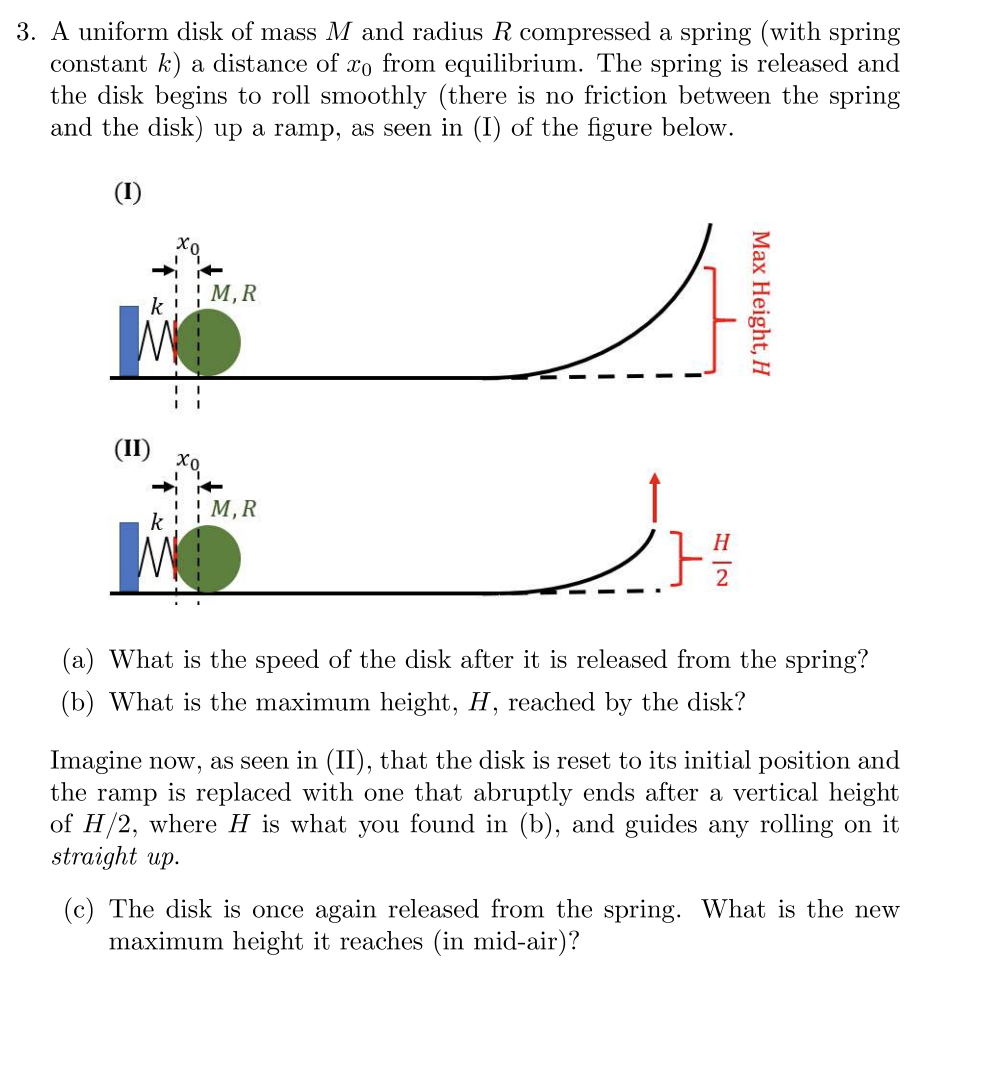3. A uniform disk of mass M and radius R compressed a spring (with spring constant k) a distance of xo from equilibrium. The spring is released and the disk begins to roll smoothly (there is no friction between the spring and the disk) up a ramp, as seen in (I) of the figure below. (1) +7 M, R (II) Max Height, H ++ k ¦¦M,R H }/ (a) What is the speed of the disk after it is released from the spring? (b) What is the maximum height, H, reached by the disk? Imagine now, as seen in (II), that the disk is reset to its initial position and the ramp is replaced with one that abruptly ends after a vertical height of H/2, where H is what you found in (b), and guides any rolling on it straight up. (c) The disk is once again released from the spring. What is the new maximum height it reaches (in mid-air)?
3. A uniform disk of mass M and radius R compressed a spring (with spring constant k) a distance of xo from equilibrium. The spring is released and the disk begins to roll smoothly (there is no friction between the spring and the disk) up a ramp, as seen in (I) of the figure below. (1) +7 M, R (II) Max Height, H ++ k ¦¦M,R H }/ (a) What is the speed of the disk after it is released from the spring? (b) What is the maximum height, H, reached by the disk? Imagine now, as seen in (II), that the disk is reset to its initial position and the ramp is replaced with one that abruptly ends after a vertical height of H/2, where H is what you found in (b), and guides any rolling on it straight up. (c) The disk is once again released from the spring. What is the new maximum height it reaches (in mid-air)?
University Physics Volume 1
18th Edition
ISBN:9781938168277
Author:William Moebs, Samuel J. Ling, Jeff Sanny
Publisher:William Moebs, Samuel J. Ling, Jeff Sanny
Chapter11: Angular Momentum
Section: Chapter Questions
Problem 96CP: A bowling ball of radius 8.5 cm is tossed onto a bowling lane with speed 9.0 m/s. The direction of...
Related questions
Question

Transcribed Image Text:3. A uniform disk of mass M and radius R compressed a spring (with spring
constant k) a distance of xo from equilibrium. The spring is released and
the disk begins to roll smoothly (there is no friction between the spring
and the disk) up a ramp, as seen in (I) of the figure below.
(1)
M, R
(II)
Max Height, H
++
k
¦¦M,R
H
}/
(a) What is the speed of the disk after it is released from the spring?
(b) What is the maximum height, H, reached by the disk?
Imagine now, as seen in (II), that the disk is reset to its initial position and
the ramp is replaced with one that abruptly ends after a vertical height
of H/2, where H is what you found in (b), and guides any rolling on it
straight up.
(c) The disk is once again released from the spring. What is the new
maximum height it reaches (in mid-air)?
Expert Solution
This question has been solved!
Explore an expertly crafted, step-by-step solution for a thorough understanding of key concepts.
Step by step
Solved in 2 steps with 2 images

Knowledge Booster
Learn more about
Need a deep-dive on the concept behind this application? Look no further. Learn more about this topic, physics and related others by exploring similar questions and additional content below.Recommended textbooks for you

University Physics Volume 1
Physics
ISBN:
9781938168277
Author:
William Moebs, Samuel J. Ling, Jeff Sanny
Publisher:
OpenStax - Rice University

Physics for Scientists and Engineers, Technology …
Physics
ISBN:
9781305116399
Author:
Raymond A. Serway, John W. Jewett
Publisher:
Cengage Learning

College Physics
Physics
ISBN:
9781938168000
Author:
Paul Peter Urone, Roger Hinrichs
Publisher:
OpenStax College

University Physics Volume 1
Physics
ISBN:
9781938168277
Author:
William Moebs, Samuel J. Ling, Jeff Sanny
Publisher:
OpenStax - Rice University

Physics for Scientists and Engineers, Technology …
Physics
ISBN:
9781305116399
Author:
Raymond A. Serway, John W. Jewett
Publisher:
Cengage Learning

College Physics
Physics
ISBN:
9781938168000
Author:
Paul Peter Urone, Roger Hinrichs
Publisher:
OpenStax College

College Physics
Physics
ISBN:
9781305952300
Author:
Raymond A. Serway, Chris Vuille
Publisher:
Cengage Learning

College Physics
Physics
ISBN:
9781285737027
Author:
Raymond A. Serway, Chris Vuille
Publisher:
Cengage Learning

Physics for Scientists and Engineers: Foundations…
Physics
ISBN:
9781133939146
Author:
Katz, Debora M.
Publisher:
Cengage Learning